Wilbur Winfield Woodward
Wilbur Winfield Woodward (January 8, 1851 – March 18, 1882) was an American painter.
Early life
Woodward was born in St. Omer, Decatur County, Indiana on January 8, 1851[1] to Missouri and Charles A. Woodward.[2][3] Shortly afterwards, they moved to St. Paul, Indiana.[1] At the age of twelve, he accompanied his father, a volunteer in the 123rd Regiment.[4][5] As a drummer,[6] the younger Woodard was "accorded a place in the martial band of the regiment and with it march from Nashville to Chatatnooga [sic], and from there to Atlanta."[4] He became a member of the veterans association, the Grand Army of the Republic.[7] He returned to St. Paul until he was sixteen, when he moved with his parents to Greensburg, Indiana.[1]
Career
Woodward studied under Charles T. Webber while in his teens, then enrolled at the McMicken School of Design, Cincinnati upon its opening in 1869. After turning down the job offer as an assistant principal at McMicken in June 1871, Woodward moved to Europe where he studied for a year at Royal Academy of Fine Arts Antwerp.[8] After moving to Paris,[9] he studied under Gérôme[8] and at the Académie Julien in Paris under Tony Robert-Fleury.[4] He then returned to Cincinnati for a year as a teacher at the McMicken School of Design,[10] before returning to Paris where he set up a studio. In 1879 he exhibited Une cour de vieux Paris (A courtyard in old Paris) at the Salon,[11][full citation needed][12] and in 1880 an Ossian, subtitled, Ossian, vieux et aveugle, restait avec la veuve de son fils, seul survivant d’une race royale et héroïque (Ossian, old and blind, left with the widow of his son, only survivor of a royal and heroic race), 67 x 116 cm.[13][full citation needed][14] In both the 1879 and 1880 Salon catalogues Woodward is recorded living at 22, Rue Monsieur-le-Prince, located between the Odéon and the Sorbonne. No. 22 is a famous old building where other artists had studios and as it has an open courtyard this possibly served for Woodward’s 1879 Salon painting. Hicok Low paints a vivid picture of Woodward in Paris, describing him as one of the "types of the quarter" who would be seen wearing a sombrero, shoulder length black hair, thigh length cavalry boots, and playing his banjo where "memories of the Ohio would resound around the walls of this Paris studio."[15] In Paris, in addition to painting, Woodward also worked a designer for French illustrated journals, and according to Low it was on commission from one of these to record the Yorktown Centennial Celebration[15] in October 1881 that he returned and unfortunately died back in Indiana in 1882, at the young age of 31.
Legacy
Smith in his The History of the state of Indiana of 1903 writes that "Wilbur Woodward, of Greenberg, gave promise of becoming one of the greatest painters in the world."[16] Woodward’s father donated Springtime to the Indianapolis Museum of Art.[3] As Woodward died so young his works are rare.A Girl removing fleas from a dog, which is signed and dated 1879, [17] was sold in Metz in 2019.[citation needed] Two modello drawings by him, a ricordo of the previously mentioned Ossian, and Summer Evening, are in the collection of the Pennsylvania Academy of the Fine Arts. Nonetheless, Burnet wrote in 1921 that Woodward's work had been acquired by leading collectors in Cincinnati and New York,[10] so more of his work may be discovered both in the United States and in France. Although the Ossian is untraced, the composition is also known through a contemporary press wood-engraving.[18]
In 1961, the Life article, "Nudes are back" included a black and white photo of Woodward's Springtime.[19]
Gallery
Works by Woodward
-
![Springtime [d]. Oil on canvas, 99 x 84 cm. Indianapolis Museum of Art.](//upload.wikimedia.org/wikipedia/commons/thumb/d/d0/Wilbur_Winfield_Woodward_-_Springtime_-_12.20_-_Indianapolis_Museum_of_Art.jpg/225px-Wilbur_Winfield_Woodward_-_Springtime_-_12.20_-_Indianapolis_Museum_of_Art.jpg) Springtime [d]. Oil on canvas, 99 x 84 cm. Indianapolis Museum of Art.
Springtime [d]. Oil on canvas, 99 x 84 cm. Indianapolis Museum of Art. -
 Girl Removing Fleas from a Dog. 1879. Oil on panel, 23 x 15 cm.
Girl Removing Fleas from a Dog. 1879. Oil on panel, 23 x 15 cm. -
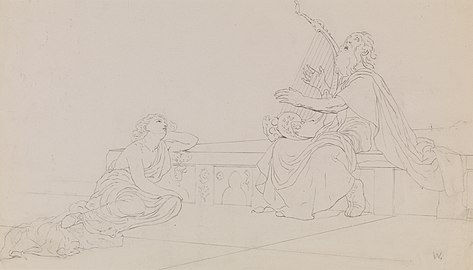 Ossian. Graphite on cream bristol board, 18.6 x 28.3 cm. Pennsylvania Academy of the Fine Arts.
Ossian. Graphite on cream bristol board, 18.6 x 28.3 cm. Pennsylvania Academy of the Fine Arts. -
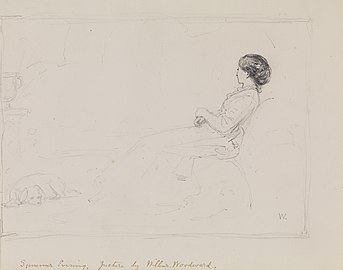 Summer Evening. Graphite on cream colored paper, 18.7 x 23.5 cm. Pennsylvania Academy of the Fine Arts.
Summer Evening. Graphite on cream colored paper, 18.7 x 23.5 cm. Pennsylvania Academy of the Fine Arts.
Depictions of Woodward's work
-
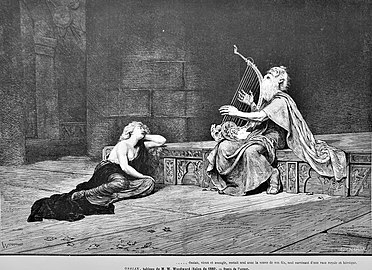 Engraving by Jamie Mulheron of Woodward's painting, Ossian, as it appeared at the Paris Salon of 1880.
Engraving by Jamie Mulheron of Woodward's painting, Ossian, as it appeared at the Paris Salon of 1880. -
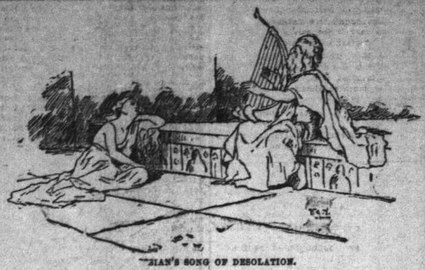 Sketch of Woodward's Ossian.
Sketch of Woodward's Ossian. -
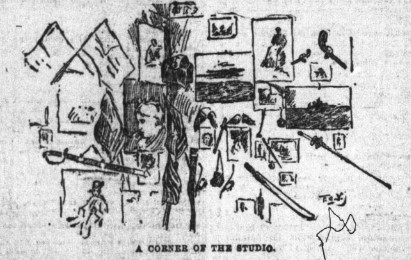 Sketch of Woodward's studio after his death in 1882.
Sketch of Woodward's studio after his death in 1882. -
 Sketch of Woodward's unfinished final painting, Dante (1882).
Sketch of Woodward's unfinished final painting, Dante (1882).
References
- ^ a b c Burnet 1921, p. 55.
- ^ "Schedule L—Free Inhabitants in St. Paul in the County of Decatur State of Illinois", United States census, 1860; St. Paul, Decatur County, Illinois; roll M653_253, page 1055, line 5, 6, and 7. Retrieved on 2023-02-07.
- ^ a b "Springtime". Indianapolis Museum of Art. Retrieved February 8, 2023.
- ^ a b c "Funeral of the artist. Wilbur W. Woodward". The Greensburg Standard. Vol. 47, no. 18. Greensburg, IN, US. May 5, 1882. p. 4 – via NewspaperArchive.
- ^ "Wedded Fifty Years". Indianapolis News. Indianapolis. December 1899 – via Hoosier State Chronicles.
- ^ Low 1908, p. 65.
- ^ ""Art Reception". Saturday Evening Journal. Retrieved February 11, 2023 – via Indiana Memory> > Pioneer Painters of Indiana > Wilbur D. Peat Research Papers.[full citation needed]
- ^ a b Haverstock et al. 2000, p. 967.
- ^ Burnet 1921, pp. 56–57.
- ^ a b Burnet 1921, p. 57.
- ^ Salon 1879, no. 1879, p. 252
- ^ Société des artistes français (1879). Catalogue illustré (in French) (1879 ed.). Paris: L. Baschet. p. 150. OCLC 231776100 – via Internet Archive.
- ^ Salon 1880, no. 1880, p. 386
- ^ Société des artistes français (1880). Catalogue illustré (in French) (1880 ed.). Paris: L. Baschet. p. 80. OCLC 231776100 – via Internet Archive.
- ^ a b Low 1908, p. 65.
- ^ Smith 1903, p. 510.
- ^ Mulherron, Jamie (October 6, 2022). "Wilbur Woodward, Fille épuçant un chien (1879)" [Wilbur Woodward, Girl Removing Fleas from a Dog (1879)]. jamiemulherron.com (in French). Retrieved February 11, 2023.
- ^ "Works of a Dead Artist: Wilbur Winfield Woodward, an Indiana Genius". The Indianapolis News. Indianapolis, Indiana. April 23, 1892. p. 5 – via newspapers.com. Also available from Indiana Memory Hosted Digital Collections Hosted by the Indiana State Library
- ^ "Nudes are back". Life. Vol. 51, no. 14. Chicago: TIME. October 6, 1961. pp. 149–155. ISSN 0024-3019. OCLC 67128145.
Sources
- Burnet, Mary Q. (1921). "III: Geirge Winter and Contemporaries". Art and artists of Indiana. New York: Century. pp. 55–57. hdl:2027/uc2.ark:/13960/t8x923t64. OCLC 260316191 – via HathiTrust.
- Haverstock, Mary Sayre; Vance, Jeannette Mahoney; Meggitt, Brian L.; Weidman, Jeffrey (2000). "Woodward, Wilbur Winfield (1851–1882)". Artists in Ohio, 1787-1900: a Biographical Dictionary. Kent, Ohio: Kent State University Press. ISBN 978-1-61277-194-6. OCLC 825116537 – via Internet Archive.
- Low, Will H. (1908). "Comrades and Camarades". A Chronicle of Friendships, 1873-1900. New York: Charles Scribner's Sons. hdl:2027/gri.ark:/13960/t5x65mp79. OCLC 271188250 – via HathiTrust.
- Smith, William Henry (1903). The history of the state of Indiana : from the earliest explorations by the French to the present time : containing an account of the principal civil, political, and military events, from 1763 to 1903. Vol. 1. Indianapolis: B.L. Blair Co. OCLC 181163925 – via Internet Archive.
External links

![Springtime [d]. Oil on canvas, 99 x 84 cm. Indianapolis Museum of Art.](http://upload.wikimedia.org/wikipedia/commons/thumb/d/d0/Wilbur_Winfield_Woodward_-_Springtime_-_12.20_-_Indianapolis_Museum_of_Art.jpg/225px-Wilbur_Winfield_Woodward_-_Springtime_-_12.20_-_Indianapolis_Museum_of_Art.jpg)

















